When I began as a Sierra Club activist in 1992, working to protect the Bolsa Chica Wetlands in Huntington Beach, the person who recruited me to join the Club asked me to go birding with him. I was terrified.
An overachiever since childhood in whatever I’d set my mind to, I hesitated to get into a new endeavor without knowing everything about it! Still, I was interested in the possibility of a “date” with this guy, even a date outdoors in nature!
“But, I don’t know enough about birds!” I told my friend, Jenny. She took out her bird book and showed me that I did know about birds. “See, you know an Eagle? And a Turkey?” I started breathing easier, but still, I knew it wasn’t enough to go “birding,” so – I don’t remember ever going on that birding date; I must have begged off.
Since 1999 I’ve lived with a biologist who is an expert birder. Besides being patient with the people he teaches, he is a great story-teller and natural history scholar, so he’s taught me enough that I think I can provide you with some hints about birding – especially the wintertime birds. The secret is not being too hard on yourself and to be patient with learning just a few birds at one time.
The easiest birds to learn, in my view, are the water birds. Some of these birds are year-round residents, but some arrive for the winter from birthplaces elsewhere. Black-necked Stilt and American Avocet were the first two I learned, as their distinctive markings made it easier. The winter plumage (feathers!) are especially beautiful for the American Avocet.
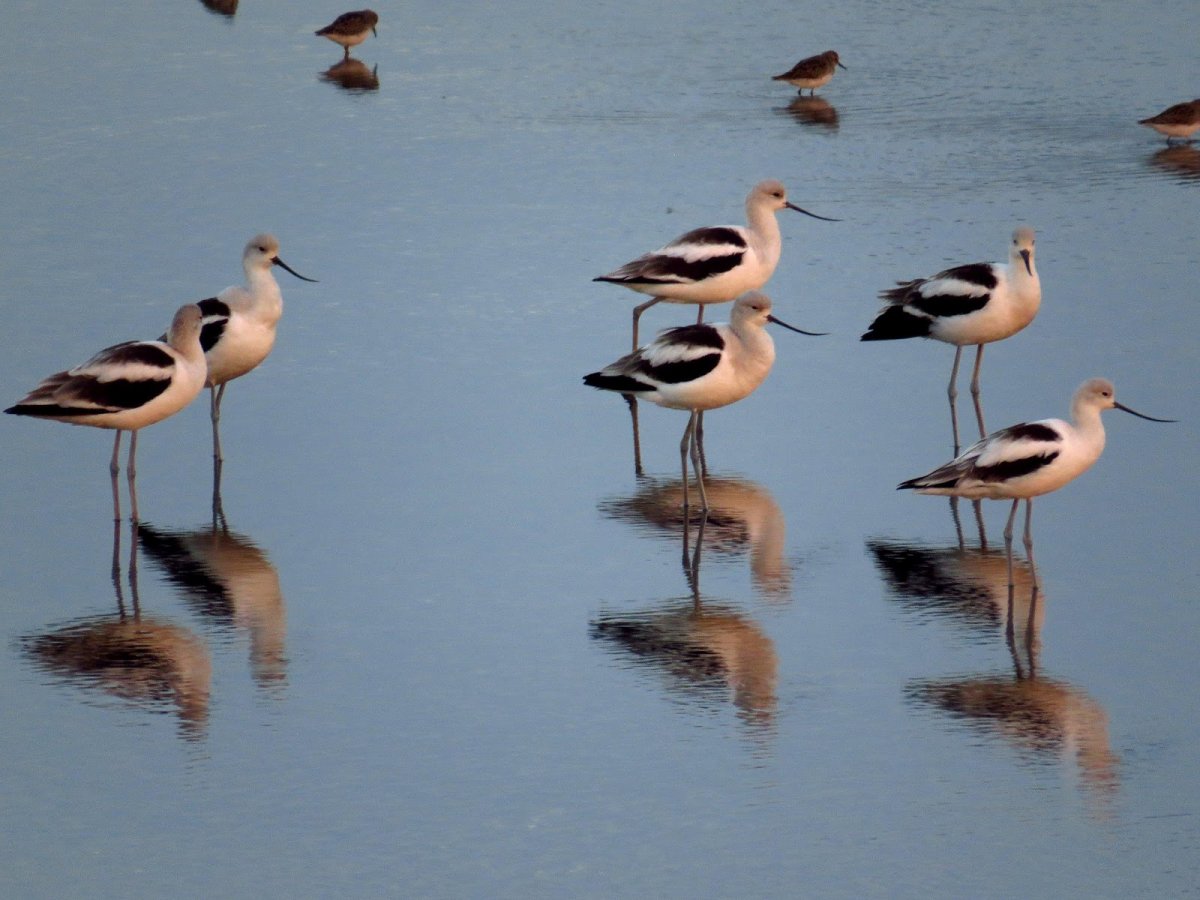
American Avocet; Jonathan Coffin all rights reserved
Great Blue Heron, Great Egret, and Snowy Egret are also easy to learn – especially if you have some hints like Snowy Egret has yellow feet and black beak; while Great Egret has black feet and yellow beak.
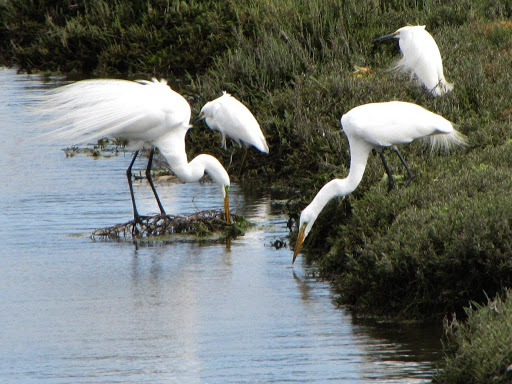
Great Egrets and Snowy Egrets photograph by Jonathan Coffin
Later, I learned about migrating songbirds that are here in LA and Orange Counties for the winter; birds like Yellow-rumped Warbler and White-crowned Sparrow. Nearly every yard sees these songbirds at some time during the winter, flying through or staying awhile for food or shelter.
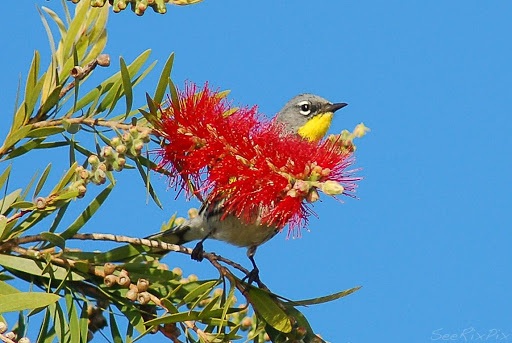
Yellow-rumped Warbler photograph by Rick Pine
The Yellow-rumped Warbler is born in mid-elevation forested lands in Western North America. I learned the White-crowned Sparrow because I was told it was possible this bird was born in Yosemite (other national park or forest lands too, but Yosemite caught my attention).
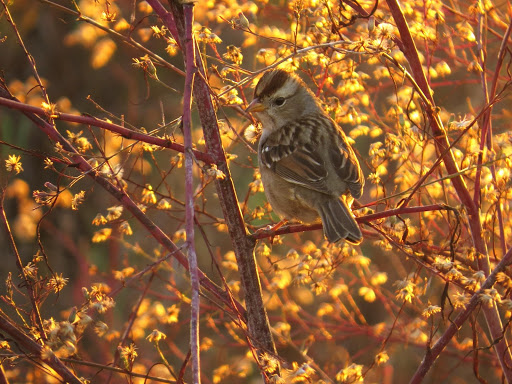
White-crowned Sparrow in Saltmarsh Aster photography by Jonathan Coffin
The California Gull is an interesting bird to have learned about – because it is usually not the Gull species you might see at the coast. Known for being born on islands in Mono Lake, they frequent inland areas, like in parking lots at the San Fernando Swap Meet adjacent to Pacoima Wash or rooftops of large buildings, which mimic the historical bare grounds of LA and Orange Counties - that were interspersed between grasslands and seasonal waterways.
Being a conservation activist, I’m especially interested in endangered and otherwise imperiled species and sub-species, like the Least Bell’s Vireo, which has – due to strong efforts made by the recovery team of the US Fish & Wildlife Service at Camp Pendleton – found its way back to willow woodlands (and willow-like-structure) habitats at the Los Angeles coast, Hansen Dam, Whittier Narrows and the Santa Ana River Narrows at Prado Dam. This sweet-sounding songbird still needs our great attention and needs the habitat found in these places to remain, and not to be altered by industrial projects.
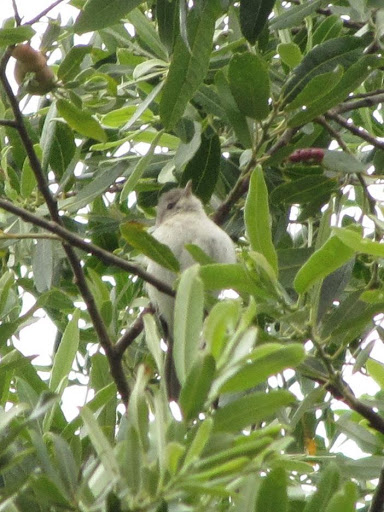
Least Bell’s Vireo photograph by Jonathan Coffin
Of course, there are so many other birds here for the winter, but I will end with a snapshot of a few of the raptors that come here. From the coast of Orange and LA Counties through the San Gabriel Mountains to the Antelope Valley in north Los Angeles County, one can see Rough-legged Hawk, Ferruginous Hawk, and Northern Harrier; Merlin and migratory Short-eared Owl, Burrowing Owl, and Northern Saw-whet Owl – are all species to learn. Some may look similar on first observation, but if you have a bird book with you, or at least on your nightstand when you arrive home after birding, or if you are fortunate enough to have a naturalist in your COVID-19 pod, then you will begin to notice the differences.
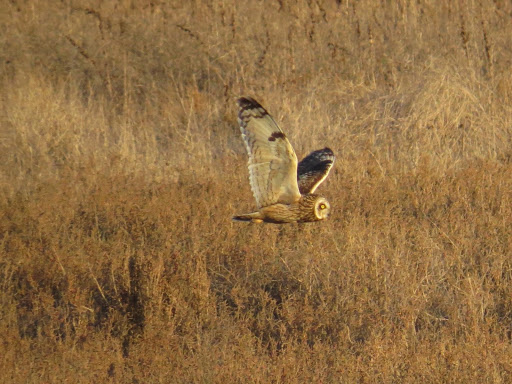
Short-eared Owl photograph by Jonathan Coffin
Notably, the Bald Eagle, a species recovering from the toxicity of DDT, has been observed during the last few weeks at the Los Angeles River in Long Beach.
If you are still a bit shy about all of these new bird names, my partner, the biologist who has taught me so much, just saw his first Williamson’s Sapsucker at Veterans Park in Sylmar. Even well-established birders have something new to see on occasion.
A favorite place to help me learn is the
Cornell Bird site – where you can see photos and learn some of the basics.
Marcia Hanscom has been a Sierra Club conservation and political leader for nearly 30 years. She received the Angeles Chapter’s highest conservation honor, the Weldon Heald Award, twice - for advocacy work on Bolsa Chica Wetlands and Ballona Wetlands.






